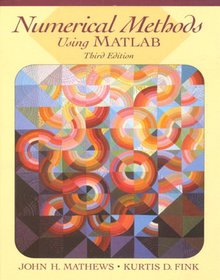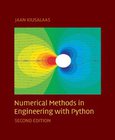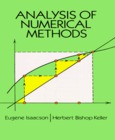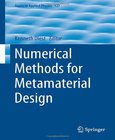Numerical Methods
Using MATLAB
3rd Edition

Book Details:
| Publisher: | Prentice Hall College Div |
| Series: | Prentice Hall , Using |
| Author: | John H. Mathews |
| Edition: | 3 |
| ISBN-10: | 0132700425 |
| ISBN-13: | 9780132700429 |
| Pages: | 662 |
| Published: | Dec 23 1998 |
| Posted: | Nov 19 2014 |
| Language: | English |
| Book format: | |
| Book size: | 18.87 MB |
Book Description:
This text provides an introduction to numerical analysis for either a single term course or a year long sequence. It is suitable for undergraduate students in mathematics, science, and engineering. Ample material is presented so that instructors will be able to select topics appropriate to their needs. *NEW-Replaces all pseudo-code algorithms with MATLAB programs, taking advantage of MATLABs widespread accessibility for educational instruction. *MATLABs structured programming style is easy for students to learn and resembles FORTRAN. *MATLAB allows for simple modification and in the exercises, students are encouraged to explore and compare modifications of algorithms. *Built-in MATLAB commands facilitate the plotting of numerical results from interpolation, curve fitting, differential equations, etc., thereby developing an important graphical understanding of problems and an invaluable sense of realism and enjoyment in numerical mathematics. *Provides a variety of examples and problems to develop and sharpen students skills in both the theory and practice of numerical analysis, includes easy-to-read proofs and worked-out examples. *Presents a wealth of tables and graphs to illustrate computer calculations in examples making the resulting numerical approximations easier to interpret. *Emphasizes why numerical methods work and their limitations, balances theory, error analysis, and readability, presents an error analysis for each method with an approach that is appropriate for the method at hand, but does not intimidate students, gives a mathematical derivation for each method that uses elementary results and builds students understanding of numerical analysis. *Offers computer assignments implementing the algorithms to give students an opportunity to practice their skills at scientific programming. *Details algorithms in pseudo-code. *Focuses on practical algorithms involving curve fitting, function approximations, numerical integration, linear systems solution, etc.
Download Link:
Related Books:
Numerical Methods in Engineering with Python
2nd Edition
Numerical Methods in Engineering with Python, 2nd Edition is a text for engineering students and a reference for practicing engineers, especially those who wish to explore Python. This new edition features 18 additional exercises and the addition of rational function interpolation. Brent's method of root finding was replaced by Ridder's method, and the Fletcher-Reeves method of optimization was dropped in favor of the downhill simplex method. Each numerical method is explained in detail, and its shortcomings are pointed out. The examples that follow individual topics fall into two categories: hand computations that illustrate the inner workings of the ...
Analysis of Numerical Methods
This excellent text for advanced undergraduates and graduate students covers norms, numerical solution of linear systems and matrix factoring, iterative solutions of nonlinear equations, eigenvalues and eigenvectors, polynomial approximation, and other topics. It offers a careful analysis and stressestechniques for developing new methods, plus manyexamples and problems. 1966 edition....
Excel for Scientists and Engineers
Numerical Methods
Learn to fully harness the power of Microsoft Excel to perform scientific and engineering calculationsWith this text as your guide, you can significantly enhance Microsoft Excel's capabilities to execute the calculations needed to solve a variety of chemical, biochemical, physical, engineering, biological, and medicinal problems. The text begins with two chapters that introduce you to Excel's Visual Basic for Applications (VBA) programming language, which allows you to expand Excel's capabilities, although you can still use the text without learning VBA. Following the author's step-by-step instructions, here are just a few of the calculations you learn to perform: Use worksheet functions to work with matrices Find roots of equations and solve syste...
Numerical Methods for Metamaterial Design
This book describes a relatively new approach for the design of electromagnetic metamaterials. Numerical optimization routines are combined with electromagnetic simulations to tailor the broadband optical properties of a metamaterial to have predetermined responses at predetermined wavelengths.After a review of both the major efforts within the field of metamaterials and the field of mathematical optimization, chapters covering both gradient-based and derivative-free design methods are considered. Selected topics including surrogate-base optimization, adaptive mesh search, and genetic algorithms are shown to be effective, gradient-free optimization strategies. Additionally, new techniques for representing dielectric distributions in two dimensions, i...
2007 - 2021 © eBooks-IT.org




